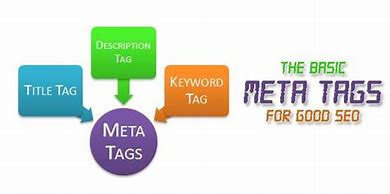What is a Meta Tag?
Meta tags are invisible tags that give search engines and website visitors information about your page.
In a nutshell, they make it easier for search engines to figure out what your content is about, which is why they’re so important for SEO.
Meta tags are found in the HTML document’s head section. As a result, they must be coded into your CMS.
Depending on the platform that supports your website, this can be simple or difficult. Meta tags or meta descriptions will have their own section in an “out of the box” solution like WordPress.
Why are Meta tags important?

- Meta tags are crucial because they influence how your site shows in search engine results pages (SERPs) and how many people will click through to your site.
- They will have an impact on your traffic and engagement rates, which will have an impact on your SEO and rankings. Meta tags are an essential component of any SEO strategy.
- Because meta descriptions are frequently the deciding factor in which results consumers click on, it’s critical to include high-quality meta tags on your web pages.
- As an example, let us say you are in the local supermarket and comparing two items. You read on the label of one and it says “this is good”. And the other says, “organically grown and harvested with care, packaged in a sterile and safe environment”. Which would you buy? And it is the same with Meta Tags.
The 3 important parts of Meta Tags.
The Title tag.
The title tag is the text that appears on search engine results pages. It’s not a meta tag, but it serves the same purpose.
How to write a good title tag:
- Add “modifiers” to your title tag (How to |The current year | Review |Best | Tips | Top |Find | Buy | Easy)
- Embed long-tail keywords in title tags
- Add numbers to your title
- Start your title tag with your main targeted keyword
- Don’t overuse your keywords
- Every page should have a unique title tag
The Description tag.
The meta description tag is where you should insert the summary of your website.
This is where you explain what your website is about and what you have to offer visitors. Because search engines only scan up to a specific amount of words, it shouldn’t be too long. a maximum of 160, but preferably over 155 for best SEO practice
How to write a good Meta Description tag.
How to write a good title tag:
- Add “modifiers” to your title tag (How to |The current year | Review |Best | Tips | Top |Find | Buy | Easy)
- Embed long-tail keywords in title tags
- Add numbers to your title
- Start your title tag with your main targeted keyword
- Don’t overuse your keywords
- Every page should have a unique title tag
Keywords
Keywords. Put all of the keywords you use on your site in the meta keywords element. This is where you want to put the words that will get you to the top of the search engine results pages. Even if the other words are removed, the user should be able to figure out what your site is about based on your keywords.
Even if meta tags aren’t very important in terms of page ranking, they’re nevertheless important because search engine robots assess their relevance to your content and site niche.
Pro tips

You can improve your SEO by including a keyword in these 55 to 60 characters. What’s more important to remember is to add value. A title with the proper keyword but one that isn’t clear will not always result in better results.
Your title tag is important not just for visitors, but also for search engines that find your material. To ensure that your title makes clear to everyone, you must combine clarity with context.
If you’re using a WordPress plugin like Yoast SEO, adding your title tag to the SEO section makes it easy to get a preview of your page and how it might appear in search results.
Checking a website’s Meta tag
Simply right-click anywhere on the page and select “View Page Source” to see the Meta tags for that page. To verify the Meta tags on any site, you can use tools like the’ SEMrush” audit tool.
Image Optimization
Image optimization has become a critical component of modern SEO because it provides a new way to rank in search results, this time using your visual content.
Both search engines and users should be able to view your images. Alt text can do both of these things: it can provide a text alternative to images that will be displayed if the image doesn’t load or read aloud by a screen reader.
And it can also notify search engines what the image represents.
You can add keywords in your picture alt text if it makes sense, but don’t keyword-stuff this tag because it can degrade the user experience for your visitors with accessibility needs.
Robots meta tag
Search engines use the robots meta tag to determine which pages on your site should be crawled. This meta tag is similar to robots.txt in that it prevents a search engine from indexing specific pages.
Robots.txt prevents a search engine from indexing an entire site or area of a site.
A robots meta tag instructs a search engine crawler not to index or follow any links on a given page.
If you don’t use the robots meta tag, crawlers will index and follow your website by default.
Why would you need to use this meta tag in the first place? It’s possible that you have certain pages on your site that are required but lacking in content.
You may not want them to appear in search results. However, because they’re still crucial to the site, you can use a no-index tag to keep them out of the SERPs.
Canonical tag
If you have similar posts on your site, you should tell the search engines which one to prioritize. It’s also possible that you have replicated content on your site that has been re-posted elsewhere.
If you employ a canonical tag, you can accomplish both of these things without risking a duplicate content penalty.
You are directing the crawlers as to which URL counts as the “primary” one, rather than confusing Google and losing your rating in the SERPs. This emphasizes the correct URL and prevents the others from detracting from your SEO.
Keeping on top of the changes.

Keeping up with Google changes is essential for a successful SEO strategy. Google can be unreliable at times, which is unfortunate for copywriters.
There are core modifications that have a significant impact on page ranking and performance, in addition to daily algorithm tweaks that go unnoticed. Google has already confirmed a number of changes for the year 2021.
More updates have been speculated by knowledgeable web-based experts, who have reported them to help others stay ahead of a shift in policy.
Google search central is a good place to keep up with these.
Conclusion
There is a lot to consider when maximizing your content for SEO, and this is just a short overview of some things that will impact on your website. Other things to consider are content, keywords, and Add sizes and placements.
To stay ahead of the pack we need to take all these points into consideration when we write for our websites. The next time you are posting try to do one extra thing you don’t normally do and it will become a habit moving forward.
Stephen is a blogger and copywriter and founder of Kool Affiliates. He provides information to others in the online world.
Any or all links on this site may be affiliate links, and if you purchase something through those links I will make a small commission on them.
There will be no extra cost to you and at times due to my affiliation, you could actually save money.
You can read our full affiliate disclosure here.

